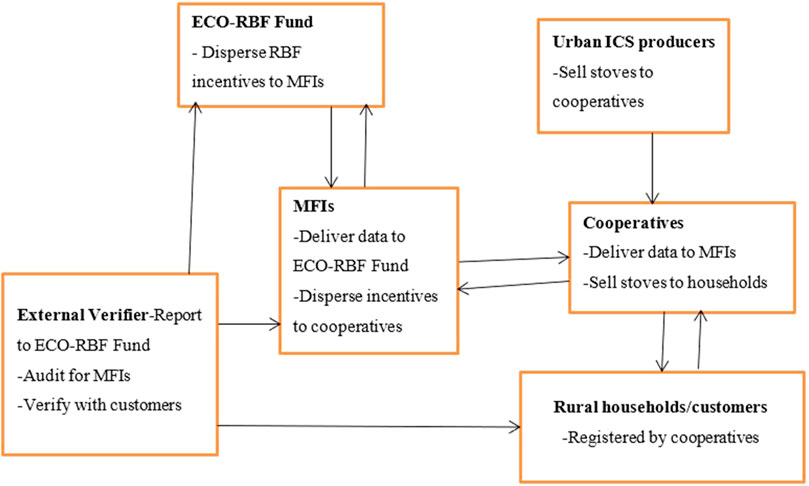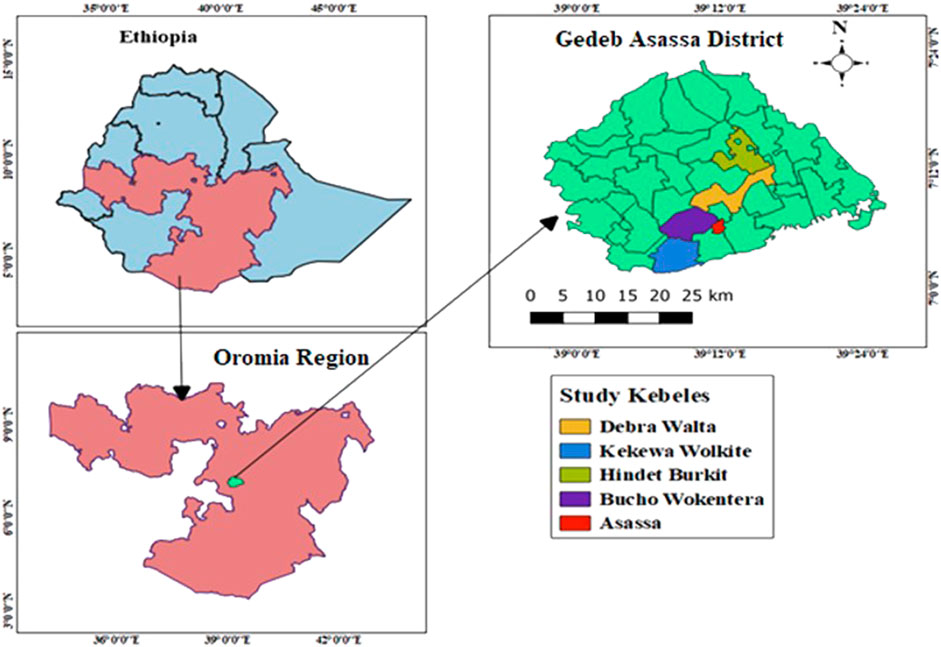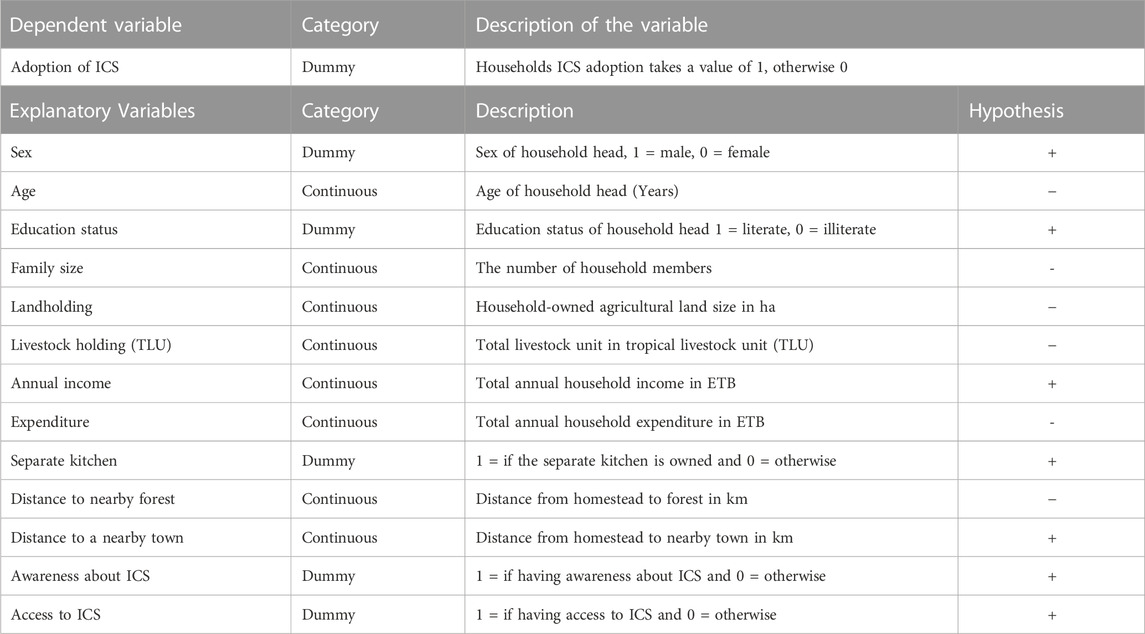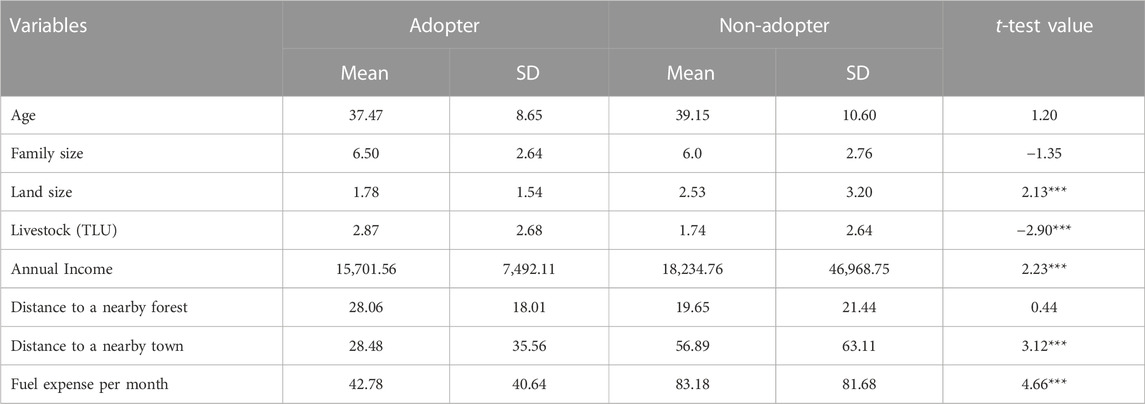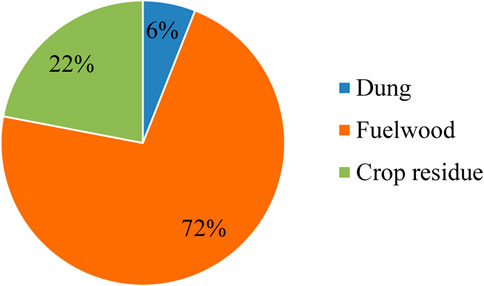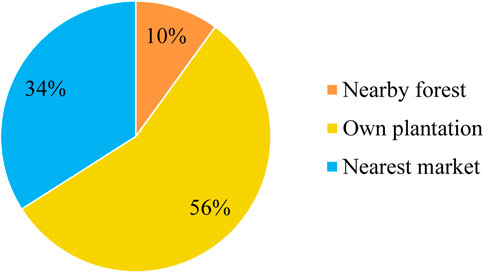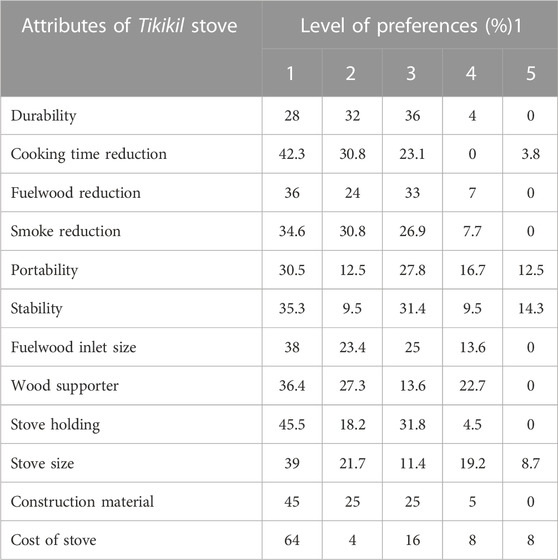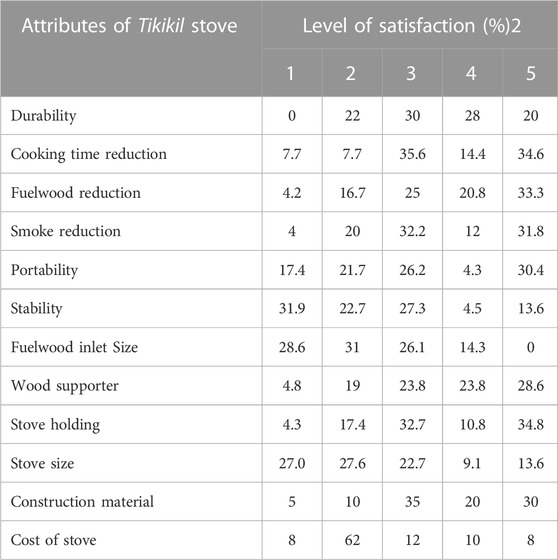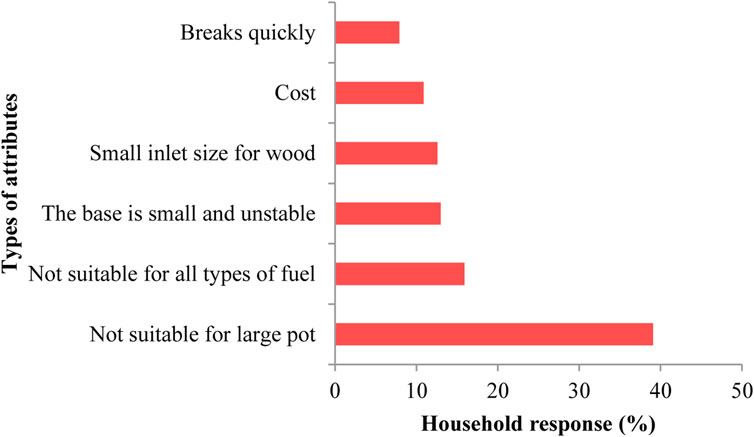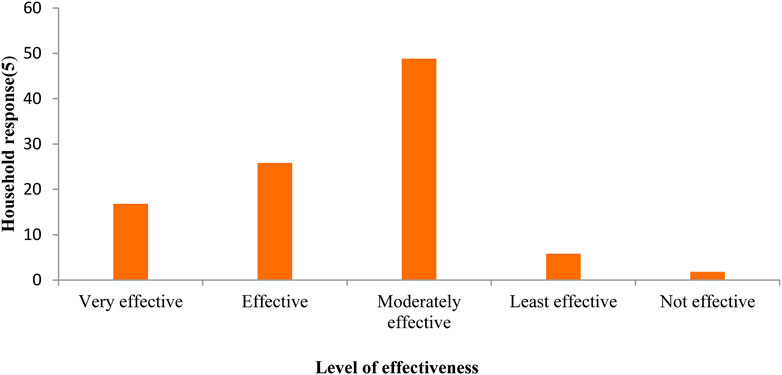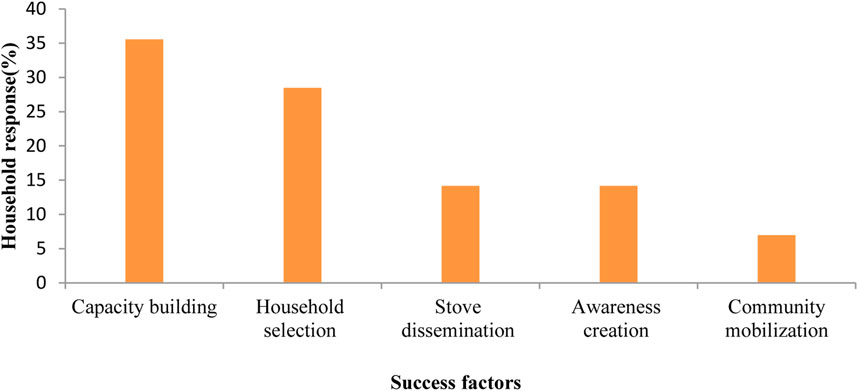- 1Ethiopian Forestry Development, Forest Products Innovation Center, Addis Ababa, Ethiopia
- 2Wondo Genet College of Forestry and Natural Resources, Hawassa University, Hawassa, Ethiopia
Environment-friendly energy practices are essential for a sustainable and quality environment in most developing countries, like Ethiopia. To achieve this, results-based financing (RBF) was implemented to distribute improved cookstove with a demand and supply side management system. However, the success of RBF is not evaluated regarding households’ preferences and adoption of the stove. This study was conducted to evaluate households’ preference and adoption of improved Tikikil stove in the RBF implementation areas. Data were collected from 191 households using a household survey and 10 focus group discussions. The data were analyzed using descriptive statistics and a binary logit regression model using STATA 16 software. The result revealed that the cost of stove, stove holding, construction material, cooking time reduction, and smoke reduction were the top five attributes ranked by user households. The dissatisfied households have complained about durability, wood inlet size, stove cost, and suitability of pot size. Results also indicated that the success of RBF program showed moderately effective. The regression result revealed that education, family size, landholding size, livestock holding, fuel expenditure, awareness, and separate kitchen were significantly and positively associated while distance to nearest town is significantly and negatively related to the adoption of Tikikil stove. The findings suggest that households need Tikikil stove options to reduce the negative effect of traditional stoves but currently available stoves lack to address the preferences of the households. In addition, different socio-economic characteristics of households and stove attributes are important factors that need to consider for the wider adoption of ICS to meet the current demand of carbon credit by reducing emissions from traditional stove.
1 Introduction
Globally, over 3 billion people rely on biomass fuels for cooking with inefficient stoves (Tamire et al., 2018; CCA, 2021). Between 80% and 90% of households in sub-Saharan African (SSA) countries still depend on biomass as their primary source of energy for cooking. Similarly, biomass is the main energy source contributing above 87% of the total energy supply in Ethiopia (Mekonnen, 2022). Nearly, 99% of rural and 80% of urban households are highly dependent on biomass energy sources (Mondal et al., 2018). Consequently, puts huge pressure on natural resources such as deforestation and forest degradation (Dresen et al., 2014). Furthermore, high dependency on traditional cookstoves can be particularly harmful to human health and have higher emissions that create hazardous indoor pollution. According to (WHO, 2018), cooking with an inefficient stove is primarily done by women, and so women and children bear the health burden associated with burning solid fuels as well as the hazards of collecting fuels.
In developing countries like Ethiopia, the advancement of renewable energy such as cookstoves are vital to overcoming the problems of biomass energy dependency with inefficient stoves. The global community has attempted to induce a transition from traditional biomass-burning cookstoves to cleaner and more efficient alternatives (WEO, 2021). Replacing those types of traditional stoves with fuel-efficient and lower-emitting improved stoves can help to mitigate problems related to traditional cookstoves (Anenberg et al., 2013). To address this challenge, numerous efforts have been undertaken by governmental and non-governmental bodies since the 1970s (Mekonnen, 2022). Thus, there have been considerable efforts aimed at improving the performance of cookstoves. The development of improved cookstoves (ICS) such as the ‘Mirt, Gonzie’, ‘Lakech, Merchayie, Tikikil, and Institutional Rocket Stove are some of the outcomes of these efforts in the country (Orange, 2011). However, efforts to enhance the uptake of clean cooking solutions have not yet succeeded at scale. The transition from traditional stove to ICS is embedded in complex and challenging parameters, including end-user needs and perceptions (Vigolo et al., 2018; Aemro et al., 2021). Understanding a set of factors related to households’ preferences and other socio-economic factors is key to enhancing the transition to clean cooking technology.
In recent times, a new approach to renewable energy was launched which is known as Results -Based Financing (RBF). The RBF is a payment mechanism that releases funding to the co-ordinating partners based upon results rather than the traditional payment structures, where payments are released as costs are incurred and the work is completed (DFID, 2015; Spalding-Fecher et al., 2015; GIZ, 2018). The RBF schemes, such as the Energising Development Programme (EnDev) or the World Bank’s Clean Cooking Fund (CCF), have become a key instrument in the clean cooking market (Stritzke et al., 2021). Most of the RBF programs in the clean cooking sector have focussed on ICS. The RBF programs in the ICS program have got donor interest from time to time but there is a limitation for documented research evidence (GIZ, 2017; Stritzke et al., 2021). As a result, there have been very few studies exploring the suitability of RBF for clean cooking, and we are not aware of any integrated clean cooking and users’ preferences of RBF programs as well as the adoption of ICS. Despite gaining increased attention, critical questions remain on the suitability of the instrument for a promising market, such as the modern energy cooking sector that lacks, to some extent, proven business and technology models and faces multiple challenges.
The RBF will support rural-based energy to buy stoves from existing urban production centers and sell these stoves to rural households; with the incentives paid to the cooperatives against the sold and verified stoves, following independent verification (GIZ, 2013). This RBF scheme allows cooperatives to engage in business by retailing ICS to rural households. Incomes are expected to be reinvested for purchasing new ICS, promotion, and the consolidation of a long-term independent supply chain that can persist when the RBF incentives conclude. In Ethiopia, there was a National Programme for Improved Household Biomass Cook Stoves Development and Promotion for the deployment of more than 11 million ICS from 2016 to 2020 (FDRE, 2014). This deployment is expected to lead to a range of benefits including a reduction in emissions of up to 14 Mt of CO2e over 3 years, a reduction of 1,000 to 2,000 deaths per year from indoor air pollution, and the creation of more than 5,000 private sector jobs.
However, evaluation of the RBF approach on the demand side regarding end-users perspectives and adoption is limited (Stritzke et al., 2021). The literature revealed that the status of research reflects the novelty of RBF approaches for clean cookstoves (CCS) in the energy sector is scant with a few exceptions (Lambe et al., 2015; Stritzke et al., 2021). Whereas, RBF programs and outcomes have been documented to some extent in technical and programme reports by the funders or implementers of RBF practices in the ICS. End-users awareness and acceptance are crucial for the success of RBF, especially in the clean cooking sector (Jürisoo et al., 2019; Jewitt et al., 2020; Stritzke et al., 2021). The adoption of new CCS requires behavioral changes to achieve the desired socio-economic or environmental impacts, for example, concerning fuel stacking, which is a well-known problem in urban and rural developmental contexts (Ochieng et al., 2020; Yadav et al., 2021). End-user contact, the collection of end-user feedback and usage tracking have been described as key components of ICS distributors in the context of RBF (Stritzke et al., 2021).
However, most of ICS studies conducted in Ethiopia focused on kitchen performance test and biomass related issues than end-users’ preference and adoption (for example, Gizachew and Tolera, 2018; Mamuye et al., 2018; Kedir et al., 2019; Mekonnen, 2022). Yet, many of ICS policies and programs have also been criticized due to their main focus on supply side of engineering works without understanding of local demand and preferences in terms of socio-economic characteristics and stove attributes (Ang’u et al., 2023; Talevi et al., 2022). Thus, users’ preferences and values are reflected through behavior which is better for understanding of user behavior could inform stove designers, policymakers and project implementers about the best approaches for ICS technology design and wider dissemination (Ahmad et al., 2022).
Therefore, understanding the stove attributes that households require and prefer to ensure the adoption and consistent use of ICS is important. The reason is that the stove would be able to meet every desired feature for every user, it is still very important for stove designers, developers, and policymakers to understand the users’ preferences and the tradeoff they face in considering adopting a new stove. Thus, this study was conducted in Southeastern Ethiopia to: 1) assess households’ preference for different attributes of Tikikil stove, 2) investigate factors influencing RBF-based Tikikil stove adoption, 3) understand households’ perception of the RBF intervention and 4) examine the success and challenges of RBF program.
2 Concepts and framework of the results-based financing approach
The applications of RBF emerged in the healthcare sector in the early 2000s (Grittner, 2013; Stritzke et al., 2021). It has been used for decades by public and private sector donors in various forms such as performance-based procurement, financing, or performance-based subsidies. Outcome-based finance includes a set of policy instruments in which incentives, rewards, or subsidies are associated with the validated delivery of predefined outcomes (EAP, 2012; GIZ, 2013). The RBF approach is used as a modality to motivate service providers using pre-agreed performance-related incentives (Spalding-Fecher et al., 2015). This approach is about changing the funding method from ‘input’ to ‘output’ and it is generally assumed that implementing this approach will require changes to the institutional framework (GIZ, 2013; Spalding-Fecher et al., 2015). One of the basic assumptions is that a division of responsibility is necessary to ensure checks and balances. Roles are typically distributed between funding agents, fund management agents, service providers, and independent verification agents.
The main aim of RBF in Ethiopia’s “Cooking Stoves” Project is to scale up the commercialization of ICS technologies through piloting a results-based financing approach (Ministry of Water and Energy, 2013). The program will overcome the gap between urban-based production of ICS and demand in rural areas. The wide-scale commercialization of ICS technologies under RBF is expected to deliver: 1) reduced deforestation and forest degradation, 2) reduced time spent in gathering firewood, 3) improved energy efficiency in domestic cooking, 4) reduced cooking times, 5) reduced the number of women and children who contract respiratory and eye problems due to prolonged exposure to poor indoor air quality, 6) employment generation and income diversification for the rural population from ICS production and marketing; and 7) reduced GHG emission.
Transaction of ICS in rural areas, under normal circumstances, drives up stove prices due to transportation and transaction costs, making them unaffordable for the majority of rural households. Most households in rural areas have very limited disposable income, so the price of a stove, even if it looks cheap, is a major factor in the purchasing decision. In addition, a lack of nearby outlets for high-efficiency stoves is a major barrier to purchasing stoves in rural areas. These facts make clear the need for financial incentives on either the supply side or the consumer side. The basic idea of RBF is to help rural energy and agricultural cooperatives purchase stoves from existing urban production centers and sell these stoves to rural households (Figure 1). The RBF incentives would be paid to the cooperatives against the sold and verified stoves (Figure 1). The RBF scheme allows cooperatives to engage in business by retailing ICS to rural households (GIZ, 2013).
The RBF has three basic models which focus on providers and have demand-side components including performance-based contracts, performance-based financing, and outcomes and results-based budgeting (Pearson, 2011; Gorter et al., 2013; Rodriguez et al., 2014). Whereas the demand side with a supply-side component focuses on providers and consumers and uses vouchers as a form of financing, finally the demand without a supply side component is primarily a consumer-focused side.
3 Methodology
3.1 Study area
The study was conducted in the Gedeb Asassa district, West Arsi zone of the Oromia Regional State, Ethiopia (Figure 2). It is located 285 km far apart from Addis Ababa; the capital city of Ethiopia (West Arsi zone, 2019). The district contains 30 kebeles with about 1,135 km2 total area coverage. The elevation of the district ranges from 2,200 to 4,180 m above sea level and the topography is characterized by mountains, hills, and plains (Bariso and Worku, 2018; Negash et al., 2018). The rainfall pattern is bimodal which ranges from 600 to 700 mm, and the mean annual temperature is between 10°C and 27°C.
Topographically, the district’s 76.9% of the land is cultivable, 17.3% pasture, 0.4% forest, and the remaining 5.4% are considered swampy, mountainous, or otherwise unusable (Negash et al., 2018). The district has forest resource potential but the natural forest coverage is decreasing from time to time at an alarming rate due to encroachment (West Arsi zone, 2019). The major sources of energy for households in the study area are dry biomass such as firewood, dung, and crop residues. By understanding these problems the local government and its development partners (i.e., GIZ EnDev) introduced energy-efficient ICS into the area during the last few years through the RBF program (GIZ, 2013; West Arsi zone, 2019). However, this study considered only Tikikil stove in one district (Gedeb Asassa district) of Oromia Regional State, Ethiopia (Figure 2).
According to (CSA, 2013), the estimated total population in the district is about 226, 743, out of these 111,853 are males and the remaining are females. About 28,949 of the population are urban dwellers and 197,794 of them reside in rural areas of the district. People in the district make their livelihood from a subsistence mixed farming system. The diversified agroecology of the area enables the production of different crops such as cereals, pulses, oil crops, vegetables; and cash crops.
3.2 Sampling technique
To select sample households, a multi-stage sampling technique was used. First, the district of Gedeb Asassa was deliberately selected because it is a potential district to promoted and disseminated Tikikil stove by RBF program in the West Arsi zone of Oromia Regional State. In the second stage, out of 30 kebeles in the district, only five potential kebeles were purposively selected based on high Tikikil disseminated through the RBF program. Third, Tikikil stove adopter and non-adopter household lists were collected from district Water and Energy office in selected sample kebeles. Fourthly, households were classified into Tikikil stove user and non-user households using a stratified random sampling technique. Finally, sample households were selected from both RBF adopter and non-adopter households using a simple random sampling method with a random number method. The number of sample households considered in the survey was determined using the formula suggested by Yamane (1967) at a 7% confidence level.
Where: N = total number of households in the five kebeles, n = required sample size, e = level of precision 7% (0.07).
3.3 Data collection
The data for this study were collected from primary and secondary sources. The collected data were considered both quantitative and qualitative data types. The main sampling units of the survey are Tikikil stove adopter and non-adopter households. During primary data collection, household survey and focus group discussions (FGD) were employed. A semi-structured questionnaire was employed to collect data from households through face-to-face interviews and a checklist was used for FGD. Before the final data collection, the questionnaire was pre-tested on 20 households. After the pre-testing, the final questionnaire was designed and collected by including the information obtained from the preliminary survey.
The household survey involved 191 randomly selected households, of which 109 were Tikikil stove adopters from the RBF program and 82 were non-adopters. The classification of households as adopters and non-adopters refers to the involvement of households in using from RBF distribution of Tikikil stove. In addition, two FGDs were conducted per kebele with 8 members per each FGD group, and a total of 10 FGDs were conducted from five sample kebeles. The choice of explanatory variables was determined based on the literature reviewed on the factors that affect households’ decisions to adopt Tikikil stove disseminated by RBF program. Accordingly, the hypothized variables were considered as explanatory variables affecting decisions made by households to adopt Tikikil stove (Table 1). The selection of those variables was based on their relation to households’ adoption of different ICS.
3.4 Data analysis
Data were analyzed using descriptive statistics and a binary logit model. Descriptive statistics such as mean, standard deviations, frequency, percentages, and the results were presented through graphs and tables. The data obtained from focus group discussions were analyzed qualitatively. In addition to this, the statistical significance and the association of the dummy and continuous variables with the dependent variable were tested using chi-square and independent sample t-test, respectively. The quantitative data were analyzed by using STATA software version 16.
Before data analysis, data management and diagnostic tests such as multicollinearity, model fit, etc., were performed to verify whether the model is correctly specified and validated. The multicollinearity test result indicated that two explanatory variables were excluded from the final binary logit regression model result due to multicollinearity problem. Hence, out of 15 explanatory variables, only 13 variables were considered in the final results of the specified model.
A binary logistic regression model was used to identify determinants of the adoption of Tikikil stove in the study area. Adoption of Tikikil stove (stove adopter = 1, non-adopter = 0) was used as a dependent variable. The mathematical model is expressed as:
1-Yi stands for the probability that the household adopts ICS and can be written as:
Then dividing Eq. (2) by Eq. 3 and simplified form gives:
Eq. 4 indicated simply the odds ratio. It was the ratio of the probability that the households adopt ICS (Yi) to the probability that households that are not adopted ICS (1-Yi).
The binary logistic regression model is obtained by taking the logarithm of Eq. 4 as presented here:
Where Ln is the logarithm of the odds ratio, which is linear in both X and the parameter. As a result, when the stochastic disturbance term µi is included:
4 Results and discussion
4.1 Characteristics of households
The majority (70.6%) of the total adopters in the sample were found to be females (Table 2). The result indicates that female-headed households are more likely to adopt than male-headed households. This finding is supported by the findings of (Mamuye et al., 2018) who found that female-headed households were more likely to associate ICS adoption than male-headed households. The education level shows that 59.6% of adopter households are educated and the vast majority (93.6%) of adopter households have awareness about ICS while 80.5% of non-adopters have no awareness about ICS (Table 2). The chi-square test shows that there is a significant difference between adopters and non-adopters in terms of awareness about ICS. The vast majority (79.8%) of adopters have a separate kitchen and there is statistically significant variation between adopters and non-adopters.
The average age of the total sample households is 37.47 and 39.15 years for adopters and non-adopters, respectively (Table 3). The average family size of adopters is 6.5 person and non-adopters is 6 person. The average land size for adopter households is 1.78 ha while for non-adopters is about 2.53 ha and shows a statistically significant difference. The average livestock holding in TLU is 2.87 and 1.74 for the adopter and non-adopter households, respectively with a significant differences. On the other hand, the amount of annual income is higher for non-adopter households than for adopters and indicates a statistically significant difference. Distance to forests and distance to nearby town shows the lower average value for adopters, and distance to town shows statistically significant variation. The average fuel expense is 42.78 and 83.18 ETB for the adopter and non-adopter households, respectively with a statically significant difference.
4.2 Fuel type and sources of fuelwood
The household survey result revealed that the majority (72%) of households used fuelwood as a major fuel type (Figure 3). In addition, 22% of households use dung cake and only 6% of households use crop residues. The results of this study are in line with the findings (Legesse et al., 2015) demonstrated that fuelwood is the main source of household energy.
Regarding fuelwood sources, the result shows that 56% of households obtained their fuelwood from their plantation forest, 34% from nearby market destinations, and only 10% of households collected from nearby natural forest (Figure 4). The FGD participants also stated that fuelwood is the main source of fuel and is obtained primarily from plantation forest.
4.3 Households’ level of preference and satisfaction
4.3.1 Households’ level of preference for Tikikil stove
Results from the household survey and FGD revealed that there is a different level of households’ preference for Tikikil stove attributes which are presented with a five-point (1 = very important, 2 = important, 3 = moderately important, 4 = least important, 5 = not important)1 Likert scale (Table 4). The household survey result indicated that most of the respondents stated their preferences from very important to moderately important for most stove attributes (Table 4). For instance, 36% of households rated it moderately important and 32% of them rated it important for its durability attribute. During FGD, households indicated that durability is an important preferred attribute for adopting the ICS. This finding is supported byliterature (Gill-wiehl et al., 2021) reviewed 40 papers and found that durability was one of the most important aspects of the stove to encourage adoption. The cooking time reduction attribute is another component of the stove that 42.3% of households stated is very important, and 36% of households stated that the fuelwood reduction attribute is very important (Table 4). Similarly, 34.6% and 30.8% of households’ ranked smoke reduction attributes as very important and important, respectively (Table 4).
The household survey result also revealed that 30.5% and 27.8% of households ranked it very important and moderately important, respectively for the portability attribute. The stability of the stove base is rated very important (35.3%) and moderately important (31.4%). The result shows that 38% of households rated very important for fuelwood inlet size and 36.4% of user households rated it very important for the wood supporter attribute (Table 4). Nearly half (45.5%) of households stated that the stove-holding attribute was very important. 39% of user households revealed that stove size is another very important Tikikil stove attribute and 45% of households also stated that construction material is very important. The majority (64%) of user households indicated that the cost of Tikikil stove is ranked very important (Table 4).
The FGD result revealed that the adoption of Tikikil stove needs to consider different stove attributes. This indicated that end-users preference is very important to manage the demand-side component of ICS promoted and disseminated by the RBF programe. The FGD participants stated that the success and failure of Tikikil stove are measured in terms of end-users preference. Previous studies show that households need a stove that meets their large cooking demands (Gill-wiehl et al., 2021). This finding demonstrated that to meet these requirements, it is important to promoters and distributers that private and public stove programs bundle stove models to meet all the households’ needs to ensure both adoption and consistent use. For example, durability, portability, pot size, stove handling, stove design and features are important indicators that accelerate the acceptance, and adoption of ICS (Sedighi and Salarian, 2017). End-user contact, the collection of end-user feedback, and usage tracking have been described as key components of ICS distributors in the context of RBF (Stritzke et al., 2021).
4.3.2 Satisfaction level of households on Tikikil stove
A five-point (Note: 1 = Not satisfied, 2 = Least satisfied, 3 = Moderately satisfied, 4 = Satisfied, 5 = Very satisfied)2. Likert scale measure was used to measure the level of satisfaction of sample households for some selected attributes of the Tikikil stove (Table 5). The household survey results showed that 30% of households rated the durability of the stove as moderately satisfied (Table 5). 35.6% of respondents also rate cooking time reduction as moderately satisfied, and 34.6% of them rated very satisfied. For the fuelwood reduction attribute, 33.3% of them were very satisfied. Similarly, for smoke reduction of Tikikil stove, 32.2% and 31.8% of households are moderately satisfied and very satisfied, respectively.
The portability attribute was rated as very satisfied by 30.4% whereas the stability of the stove attribute was not satisfied by 31.9% of the respondents. On the other hand, fuelwood inlet size is rated as less satisfied by 31% of the sample households. The wood supporter is also rated as very satisfied (28.6%) followed by satisfied and moderately satisfied, and stove holding was rated as very satisfied by 34.8%. On the contrary, the stove size attribute was rated as least satisfied by 27.6% of sample households, respectively. Construction material was also rated moderately satisfied (35%) and very satisfied (30%), respectively. The majority (62%) of respondents stated that the cost of the stove is rated as least satisfied (Table 5).
The FGD participants indicated that the RBF approach of ICS promotion and distribution is more important to sustain the demand and supply of the stove than other approaches. The RBF mechanism most importantly provides more access to ICS to users at their residence area without traveling long distances. This is supported by previous findings that indicated the success of ICS project significantly relied on the potential of the stoves to satisfy local users’ preferences (Kapfudzaruwa et al., 2017).
On the other hand, the result of the household survey and FGD revealed that user households have complained about different attributes of the Tikikil stove to modify and further improve for better acceptance and adoption. The household survey indicated that 39.2% of the dissatisfied households complained that the Tikikil stove is not suitable for large pots (Figure 5). Others also complained such as the stove is not suitable for all fuel types, the base is too small and not stable, the small inlet size to use wood, the cost of the stove, and the durability of the stove (Figure 5). Focus group discussants stated that the Tikikil stove is not suitable for large pots and all fuel types as well as it has a small inlet for wood.
4.4 Effectiveness and success of results-based financing intervention
The household survey and FGD results revealed that the effectiveness of RBF intervention on the Tikikil stove was rated at different levels. The household survey result indicated that 49% of respondents stated that RBF intervention was moderately effective. However, some proportion of respondents points out that the RBF intervention was effective, very effective, and least effective (Figure 6). The result suggests that the majority of respondents indicated that RBF intervention was moderately effective. The FGD result indicated that the effectiveness of RBF implementation is not as expected. This finding is very important because the collection of end-user feedback and usage tracking has been described as key components of ICS distributors in the context of RBF (Stritzke et al., 2021).
The unsatisfied households stated different causes of RBF intervention failure for the Tikikil stove (Figure 7). The finding revealed that capacity-building related problem is one of the major problems that accounts followed by inappropriate household selection in different implementation stages of the project, stove dissemination problem, and awareness problems for Tikikil stove failure (Figure 7). In addition, the FGD result revealed that the success of ICS promotion and distribution is hindered by different factors such as weak capacity-building, user household selection problems, awareness, and weak community mobilization. The finding of the result was supported by related studies (Kapfudzaruwa et al., 2017) demonstrated that there is a good level of awareness regarding the implementation of ICS technologies enhances the uptake of the technology by the community and increases the success of the project.
4.5 Binary logit model estimation result
To examine the determinants for the adoption of an improved Tikikil stove, a binary logistic regression model was used (Table 6). Out of 15 explanatory variables, only 13 variables were considered in the final binary logit regression model result due to multicollinearity problem. The likelihood ratio of chi-square result (LRχ2 (13) = 45.93, at p-value = 0.0000) indicated that there is significant association between explanatory variables correlated with the adoption of Tikikil stove that disseminated by RBF program, and model estimation was observed at a probability level of 1%. The likelihood ratio of chi-square p-value (p = 0.0000) indicated that the model was well-fitted at p < 0.01 significance level. The Nagelkerke R square (Pseudo R2) value was 0.6851 (68.51%) which indicated that there is a moderately strong relationship of 68.51% between the predictors and the prediction (Table 6).
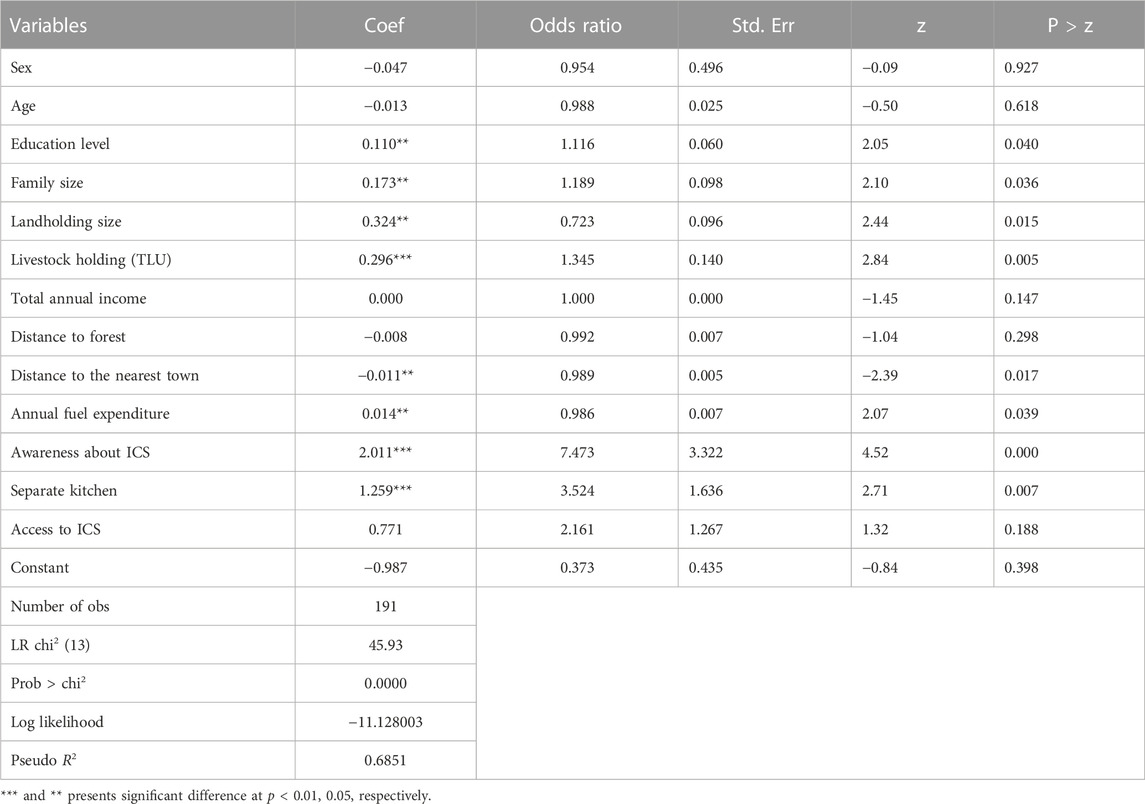
TABLE 6. Influence of various explanatory variables on the adoption of Tikikil stove within the RBF program.
Among explanatory variables, education level shows a positive and significant relationship with the adoption of Tikikil stove from RBF intervention (Table 6). In most adoption studies, education was found to be the main tool in facilitating technology uptakes (Guta, 2020; Karanja and Gasparatoes, 2020). Another finding revealed that the positive association between education and ICS adoption might be related to access to a full package of information about the technologies (Beyene and Koch, 2013). This finding suggests that educated household heads are more informed about new technologies and are more likely able to process information.
Family size is an important household characterstics that shows a positive and significant association with the probability of the household’s adoption of Tikikil stove (Table 6). The finding implies that family size has an important role that could be played by the availability of family labor. That means the presence of more labor enables households to use Tikikil stove due to the tendency of getting better income with a larger number of adults in the household. This finding is consistent with the findings of (Gizachew and Tolera, 2018; Guta, 2020; Yayeh et al., 2021) who demonstrated that household family size has a positive effect on the adoption of ICS. On other hand, it contradicts the finding (Karanja and Gasparatos, 2020) who found a negative effect.
Household assets such as livestock holding and landholding are important indicators of ICS adoption decisions (Table 6). For example, livestock holding with tropical livestock unit (TLU) was associated positively and significantly with households’ adoption of a Tikikil stove at a 1% significance level. This implies that the higher the number of livestock owned by the household, the better-off the household, and the higher the financial capacity to pay and purchase the Tikikil stove. The finding of this study is in line with the findings of (Legesse et al., 2015) who found that livestock holding has a positive and significant association with the adoption of ICS because of that livestock is an asset that increases the purchasing power of the household. But it contradicts that of (Guta, 2020) who found that livestock holding has a negative influence on the adoption of ICS. Similarly, landholding size has a positive and significant influence on the adoption of the Tikikil stove. The larger the landholding size, the richer the households and the higher will be the financial capacity to invest in energy technologies. The result is agreed with the findings of (Guta, 2020; Karanja and Gasparatos, 2020) who found that land ownership is a crucial asset and it is an important determinant of energy technology adoption.
Distance to nearby town and the adoption of Tikikil stove had a negative and significant correlation at 5% probability level. This shows that if the distance to the town increased by 1 km, the probability of households’ adopting the Tikikil stove decreased (Table 6). This implies that households who are far away from the nearby town are less likely to adopt the Tikikil stove than households who are near the town. This finding is in line with the works of (Legesse et al., 2015; Kassa et al., 2020) who found that the distance from nearby town affects significantly and negatively the adoption of ICS.
There is a positive and significant relationship between awareness and adoption of Tikikil stove. This indicates that, as individuals become more aware of the benefits of the ICS, the probability of adopting that Tikikil stove increases. The finding of this study agreed with related studies (Sheha and Makame, 2017; Kassa et al., 2020) who demonstrated that the level of awareness had a positive and significant influence on the adoption of improved energy-saving ICS. Therefore, this study suggests that raising the awareness level of rural households would help them to decide on the adoption and sustained use of more energy-efficient ICS.
A separate kitchen has a positive and significant effect on the adoption of Tikikil stove (Table 6). This shows that having enough cooking space and the capacity to construct a separate kitchen plays an important role in the adoption of Tikikil stove. The finding agreed with other similar studies (Gizachew and Tolera, 2018) demonstrated that a separate kitchen is one of the criteria to adopt ICS. Household stove preferences arose in the literature related to how the stove affects the cooking area and households needed a stove that fit within their limited kitchen space (Gebreegziabher et al., 2018). Fuel expenditure has also positive and significant association with the adoption of Tikikil stove. This implies that households are more likely to adopt Tikikil stove when they spent more money for fuel purchases.
5 Conclusion and policy implications
The aim of ICS intervention through RBF programs is to reduce the negative socioeconomics, health, and environmental implications associated with biomass fuel combustion with supply and demand side management. However, the success of ICS distribution with the RBF programe depends on the adoption and proper use of ICS through behavior change and keeping the preferences of households at the individual and the community level. The results of this study revealed that the preferences and adoption of ICS depend on the socio-economic characteristics and stove attributes. The results of households’ level of preferences are affected by ICS attributes such as cost of stove, stove holding, construction material, cooking time reduction, and smoke reduction were the top five attributes ranked by user households for Tikikil stove. The implications of fuel-saving on time and efforts households spent in collecting firewood have been reported by the households as one of the very important benefits of the Tikikil stove. The adoption rate was relatively low due to the small wood inlet size of the stove which does not accommodate the type of wood being used by some households; the cost of the stove, not suitable for large pots, not suitable for all types of fuels, lack of replacement, lack of maintenance and small base of the stove. The result also showed that the effectiveness of RBF intervention on ICS regarding established goals is moderately effective. Results from the binary logit model revealed that education level, family size, landholding size, livestock holding, distance to the nearest town, annual fuel expenditure, awareness about ICS, and separate kitchen significantly influenced households’ decision for the adoption of the improved Tikikil stove.
The findings also suggested that consideration and integration of various household preferences and households’ socio-economic characteristics are relevant in the design of ICS for the success of the RBF program. The multiple features of ICS is important to meet the preferences of households in different environmental conditions and socio-cultural settings. Thus, government and development organizations should work in partnership with the private sector could further explore the possibilities of scaling up Tikikil stove projects as one key strategy to achieve the dual objective of developing sustainable livelihoods and improving the environment. The findings further suggest that consideration of the improvement of the Tikikil stove small wood inlet size to accommodate the type of wood being used; cost of the stove, suitable for a large pot and all types of fuels, maintenance, and replacement, as well as base of the stove. Essential mechanisms for the success of such programs are local awareness of new solutions and their acceptance, socio-cultural adaption, and technological innovation. Generally, stove designers, producers and pricing policy should focused on the preference of households regarding stove attributes, socio-economic characteristic and related factors for wider dissemination and adoption of ICS. Hence, enhance the current issues of climate benefits to meet the demand of high quality carbon credit through emission reduction.
6 Suggested strategies for wider implementation of results-based financing program
The result suggests that product testing, design modification, product promotion and market expansion should be conducted in order to address preferences of households as appropriate on the attributes of stoves. The project should seriously consider the need for continuous product improvement through basic adaptive research that would enable it respond to the changing market conditions, household preferences, and improve the affordability and marketability of the stoves. In order to achieve critical mass and maximize benefits, the RBF program should expand the frontiers of Tikikil stove market. The stoves market should also be expanded carefully selected new areas through further decentralization of production centers in an optimal manner. It is necessary that government and non-governmental actors like GIZ should strengthen the efforts of the Developmental Association for Renewable Energies in disseminating Tikikil stoves as well as others throughout the country. For this to be successful, there is need to intensify awareness campaigns on ICS through mass media, provision of credit facilities, and investing in rural roads infrastructure. This implies that ICS programs need to be integrated into sustainable rural development strategies and programs. The findings of this study also stongly suggests that roles and responsibilities of partners at federal, regional, zonal, Woreda and kebele level should be clearly defined. It is also recommended that networks be created across sectors that encourage learning and experience sharing that can contribute to greater management and efficiency of running the RBF schemes.
Data availability statement
The raw data supporting the conclusion of this article will be made available by the authors, without undue reservation.
Ethics statement
The studies involving human participants were reviewed and approved by the GIZ. The patients/participants provided their written informed consent to participate in this study.
Author contributions
AB: Proposal development, data collection, data analysis, manuscript writing and editing; YM: Proposal development and manuscript editing. All authors listed have made a substantial, direct, and intellectual contribution to the work and approved it for publication.
Acknowledgments
The authors acknowledge the GIZ EnDev energy program of Ethiopia for the financial support for data collection of this study. Our special appreciation goes to the GIZ EnDev energy program of Ethiopia’s cooking component staff for providing us with material support. We would like to thank Gedeb Asassa district Water Irrigation and Energy office, West Arsi zone agricultural and natural resource office for providing us with relevant information. Our special gratitude goes to all households, enumerators, and others who participated directly or indirectly in this study.
Conflict of interest
The authors declare that the research was conducted in the absence of any commercial or financial relationships that could be construed as a potential conflict of interest.
Publisher’s note
All claims expressed in this article are solely those of the authors and do not necessarily represent those of their affiliated organizations, or those of the publisher, the editors and the reviewers. Any product that may be evaluated in this article, or claim that may be made by its manufacturer, is not guaranteed or endorsed by the publisher.
Footnotes
1Note: 1= very important, 2=important, 3= moderately important, 4= least important, 5= not important.
2Note: 1= Not satisfied, 2= Least satisfied, 3= Moderately satisfied, 4= Satisfied, 5= Very satisfied.
References
Aemro, Y. B., Moura, P., and de Almeida, A. T. (2021). Experimental evaluation of electric clean cooking options for rural areas of developing countries. Sustain. Energy Technol. Assessments 43, 100954. doi:10.1016/j.seta.2020.100954
Ahmad, R., Ilyas, H. N., Li, B., Sultan, M., Amjad, M., Aleem, M., et al. (2022). Current challenges and future prospect of biomass cooking and heating stoves in Asian Countries. Front. Energy Res. 10, 880064. doi:10.3389/fenrg.2022.880064
Anenberg, S. C., Balakrishnan, K., Jetter, J., Masera, O., Mehta, S., Moss, J., et al. (2013). Cleaner cooking solutions to achieve health, climate, and economic cobenefits. Environ. Sci. Technol. 47, 3944–3952. doi:10.1021/es304942e
Ang’u, C., Muthama, N. J., Mutuku, M. A., and M’Ikiugu, M. H. (2023). Determinants of the sustained use of household clean fuels and technologies: Lessons from Vihiga county, Kenya. Energy Rep. 9, 1990–2001. doi:10.1016/j.egyr.2023.01.026
Bariso, M., and Worku, Y. (2018). Cattle ticks and tick borne haemoparasite species identification and associated risk factors in two districts of West Arsi Zone, Ethiopia. J. Veterinary Sci. Animal Husb. 6 (5), 501. http://www.annexpublishers.com/articles/JVSAH/6501-Cattle-Ticks-and-Tick-Borne-Haemoparasite-Species-Identification-and-Associated-Risk-Factors-in-Two-Districts-of-West-Arsi-Zone-Ethiopia.pdf.
Beyene, A. D., and Koch, S. F. (2013). Clean fuel-saving technology adoption in urban Ethiopia. Energy Econ. 36, 605–613. doi:10.1016/j.eneco.2012.11.003
CCA, (2021). Organization overview. The impacts of building an inclusive clean cooking industry. https://cleancooking.org/mission-impact/.
CSA, (2013). Population projection of Ethiopia for all regions at the woreda level from 2014-2017. Central Statistical Agency of Ethiopia. https://www.academia.edu/30252150/Federal_Democratic_Republic_of_Ethiopia_Central_Statistical_Agency_Population_Projection_of_Ethiopia_for_All_Regions_At_Wereda_Level_from_2014_2017.
DFID, (2015). Designing and delivering payment by results programmes: A DFID smart guide. London, UK: DFID. https://assets.publishing.service.gov.uk/government/uploads/system/uploads/attachment_data/file/352519/Designing-Delivering-PbR-Programmes.pdf.
Dresen, E., DeVries, B., Herold, M., Verchot, L., and Müller, R. (2014). Fuelwood savings and carbon emission reductions by the use of improved cooking stoves in an Afromontane forest, Ethiopia. Land 3 (3), 1137–1157. doi:10.3390/land3031137
EAP, (2012). Clean stove initiative knowledge exchange series, results based financing: Framework for promoting clean stoves. https://documents1.worldbank.org/curated/en/838501468189549922/pdf/97846-REVISED-LW46-Fin-Logo-OKR.pdf.
FDRE, (2014). Ethiopia’s climate-resilient green economy climate resilience strategy: Water and energy, draft, ministry of water, irrigation and energy. Ethiopia: Federal Democratic Republic of Ethiopia FDRE.
Gebreegziabher, Z., Beyene, A. D., Bluffstone, R., Martinsson, P., Mekonnen, A., and Toman, M. A. (2018). Fuel savings, cooking time and user satisfaction with improved biomass cookstoves: Evidence from controlled cooking tests in Ethiopia. Resour. Energy Econ. 52, 173–185. doi:10.1016/j.reseneeco.2018.01.006
Gill-wiehl, A., Price, T., and Kammen, D. M. (2021). Energy research and social science what's in a stove ? A review of the user preferences in improved stove designs. Energy Res. Soc. Sci. 81, 102281. doi:10.1016/j.erss.2021.102281
GIZ, (2017). Evaluation of the results-based financing for low carbon energy access facility (RBFF) within energising development (EnDev). https://www.preventionweb.net/files/61504_ethiopiacrge.pdf.
GIZ, (2013). Proposal for a results-based financing (RBF) measure in Ethiopia “improved cook stoves” within the energising development (EnDev) programme. https://energypedia.info/images/9/99/Brochure_Bonn_International_Cooking_Energy_Forum_2013.pdf.
GIZ, (2018). Results-based financing for energy access—how to design and implement projects: Lessons from the field. Bonn, Germany: GIZ. https://endev.info/wp-content/uploads/2021/07/EnDev_RBF_Lessons_learnt_Report_2018.pdf.
Gizachew, B., and Tolera, M. (2018). Adoption and kitchen performance test of improved cookstove in the Bale Eco-Region of Ethiopia. Energy Sustain. Dev. 45, 186–189. doi:10.1016/j.esd.2018.07.002
Gorter, A. C., Ir, P., and Meessen, B. (2013). “Evidence review, results-based financing of maternal and newborn health care in low-and lower-middle-income countries,” in Programme to foster innovation learning and evidence in health programmes of the German development cooperation(profile) (Bonn, Germany: OECD). https://www.oecd.org/dac/peer-reviews/Evidence-RBF-maternal-health.pdf.
Grittner, A. M. (2013). Results-based Financing: Evidence from performance-based financing in the health sector (No. 6/2013). http://hdl.handle.net/10419/199392.
Guta, D. D. (2020). Determinants of household use of energy-efficient and renewable energy technologies in rural Ethiopia. Technol. Soc. 61, 101249. doi:10.1016/j.techsoc.2020.101249
Jewitt, S., Atagher, P., and Clifford, M. (2020). We cannot stop cooking”: Stove stacking, seasonality and the risky practices of household cookstove transitions in Nigeria. Energy Res. Soc. Sci. 61, 101340. doi:10.1016/j.erss.2019.101340
Jürisoo, M., Serenje, N., Mwila, F., Lambe, F., and Osborne, M. (2019). Old habits die hard: Using the energy cultures framework to understand drivers of household-level energy transitions in urban Zambia. Energy Res. Soc. Sci. 53, 59–67. doi:10.1016/j.erss.2019.03.001
Kapfudzaruwa, F., Fay, J., and Hart, T. (2017). Improved cookstoves in Africa: Explaining adoption patterns. Dev. South. Afr. 34 (5), 548–563. doi:10.1080/0376835X.2017.1335592
Karanja, A., and Gasparatos, A. (2020). Adoption of improved biomass stoves in Kenya: A transect-based approach in kiambu and muranga counties. Environ. Res. Lett. 15 (2), 024020. doi:10.1088/1748-9326/ab63e2
Kassa, S., Admasu, W., and Yesgat, S. (2020). Factors affecting the adoption of fuel-efficient stove in dessie zuria woreda, amhara regional state, Ethiopia. Asian J. Agric. Ext. Econ. Sociol. 38 (7), 84–97. doi:10.9734/ajaees/2020/v38i730378
Kedir, M. F., Bekele, T., and Feleke, S. (2019). Problems of Mirt, and potentials of improved Gonzie and traditional open cook stoves in biomass consumption and end use emission in rural wooden houses of Southern Ethiopia. Sci. Afr. 3, e00064. doi:10.1016/j.sciaf.2019.e00064
Lambe, F., Jürisoo, M., Lee, C., and Johnson, O. (2015). Can carbon finance transform household energy markets? A review of cookstove projects and programs in Kenya. Energy Res. Soc. Sci. 5, 55–66. doi:10.1016/j.erss.2014.12.012
Legesse, W., Derese, A., and Samuel, T. (2015). Determinants of adoption of improved stove technology in dendi district, west shoa, Oromia regional state, Ethiopia. Am. J. Hum. Ecol. 4 (4), 69–78. doi:10.11634/216796221504731
Mamuye, F., Lemma, B., and Woldeamanuel, T. (2018). Emissions and fuel use performance of two improved stoves and determinants of their adoption in Dodola, southeastern Ethiopia. Sustain. Environ. Res. 28 (1), 32–38. doi:10.1016/j.serj.2017.09.003
Mekonnen, B.A. (2022). Thermal efficiency improvement and emission reduction potential by adopting improved biomass cookstoves for sauce-cooking process in rural Ethiopia. Case Stud. Therm. Eng. 38 (2022), 102315. doi:10.1016/j.csite.2022.102315
Ministry of Water and Energy, (2013). National programme for improved household biomass cook stoves development and promotion in Ethiopia. Bonn, Germany: OECD.
Mondal, A. H., Bryan, E., Ringler, C., Mekonnen, D., and Rosegrant, M. (2018). Ethiopian energy status and demand scenarios: Prospects to improve energy efficiency and mitigate GHG emissions. Energy 149, 161–172. doi:10.1016/j.energy.2018.02.067
Negash, W., Tadesse, T., Alemayehu, G., and Bedada, H. (2018). Epidemiology of small ruminants lungworm in Gedeb Asasa district, West Arsi zone, Ethiopia. Sci. J. Zoology 7 (1), 88–96. doi:10.14196/sjz.v7i1.2479
Ochieng, C. A., Zhang, Y., Nyabwa, J. K., Otieno, D. I., and Spillane, C. (2020). Household perspectives on cookstove and fuel stacking: A qualitative study in urban and rural Kenya. Energy sustain. Dev. 59, 151–159. doi:10.1016/j.esd.2020.10.002
Orange, C. L. (2011). Enhancing markets for delivery of improved cookstove development and promotion support program in Ethiopia evaluation of current state o f technology. Testing, and production capacity and future program recommendations. Addis Ababa, Ethiopia: Development and Promotion Support Program in Ethiopia.
Pearson, M. (2011). Results-based aid and results-based financing: What are they? Have they delivered results? London: HLSP Institute. https://www.eldis.org/document/A62127.
Rodriguez, D., Suardi, M., Ham, M., Mimmi, L., and Goksu, A. (2014). Applying results-based financing in water investments. https://openknowledge.worldbank.org/handle/10986/20041.
Sedighi, M., and Salarian, H. (2017). A comprehensive review of technical aspects of biomass cookstoves. Renew. Sustain. Energy Rev. 70, 656–665. doi:10.1016/j.rser.2016.11.175
Sheha, H., and Makame, O. (2017). Adopt. new highly Effic. Cook. stoves by urban households Zanzibar, Tanzan. 9, 320–327. doi:10.5897/JDAE2017.0854
Spalding-Fecher, R., Sammut, F., and Ogunleye, J. (2015). Promoting energy access through Results-Based Finance within the framework of the CDM: Assessing business models. Washington, DC, USA: World Bank.https://ci-dev.org/knowledge-center/promoting-energy-access-through-results-based-finance-within-framework-cdm.
Stritzke, S., Sakyi-Nyarko, C., Bisaga, I., Bricknell, M., Leary, J., and Brown, E. (2021). Results-based financing (RBF) for modern energy cooking solutions: An effective driver for innovation and scale? Energies 14, 4559. doi:10.3390/en14154559
Talevi, M., Pattanayak, S. K., Das, I., Lewis, J. J., and Singha, A. K. (2022). Speaking from experience: Preferences for cooking with biogas in rural India. Energy Econ. 107, 105796. doi:10.1016/j.eneco.2021.105796
Tamire, M., Addissie, A., Skovbjerg, S., Andersson, R., and Lärstad, M. (2018). Socio-cultural reasons and community perceptions regarding indoor cooking using biomass fuel and traditional stoves in rural Ethiopia: A qualitative study. Int. J. Environ. Res. Public Health 15 (9), 2035. doi:10.3390/ijerph15092035
Vigolo, V., Sallaku, R., and Testa, F. (2018). Drivers and barriers to clean cooking: A systematic literature review from a consumer behavior perspective. Sustainability 10, 4322. doi:10.3390/su10114322
WEO, (2021). World energy outlook 2021. https://iea.blob.core.windows.net/assets/4ed140c1-c3f3-4fd9-acae-789a4e14a23c/WorldEnergyOutlook2021.pdf.
WHO, (2018). Burden of disease from the joint effects of household and ambient Air pollution for 2016 (Issue May). https://cdn.who.int/media/docs/default-source/air-quality-database/aqd-2018/ap_joint_effect_bod_results_may2018.pdf.
Yadav, P., Davies, P. J., and Asumadu-Sarkodie, S. (2021). Fuel choice and tradition: Why fuel stacking and the energy ladder are out of step? Sol. Energy 214, 491–501. doi:10.1016/j.solener.2020.11.077
Keywords: adoption, binary logit, preference, results-based financing, Tikikil stove
Citation: Belachew A and Melka Y (2023) Preferences and adoption of improved cookstove from results-based financing program in Southeastern Ethiopia. Front. Energy Res. 11:1147545. doi: 10.3389/fenrg.2023.1147545
Received: 18 January 2023; Accepted: 09 May 2023;
Published: 06 July 2023.
Edited by:
Michael Carbajales-Dale, Clemson University, United StatesReviewed by:
Sunil K. Sansaniwal, Malaviya National Institute of Technology, Jaipur, IndiaVandit Vijay, Sardar Swaran Singh National Institute of Renewable Energy, India
Copyright © 2023 Belachew and Melka. This is an open-access article distributed under the terms of the Creative Commons Attribution License (CC BY). The use, distribution or reproduction in other forums is permitted, provided the original author(s) and the copyright owner(s) are credited and that the original publication in this journal is cited, in accordance with accepted academic practice. No use, distribution or reproduction is permitted which does not comply with these terms.
*Correspondence: Azmera Belachew, YXptZXJhYmVsYWNoZXdAZ21haWwuY29t
 Azmera Belachew
Azmera Belachew Yoseph Melka
Yoseph Melka